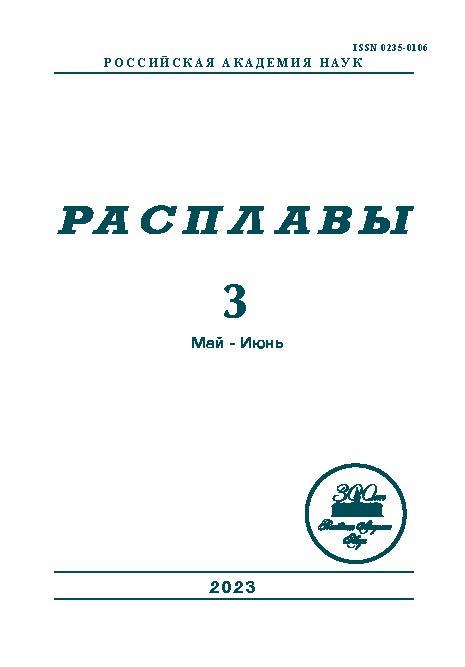LIQUIDUS TEMPERATURE AND DENSITY OF СsBr–KBr–MoBr3 MELTS
- 作者: Isakov A.1, Khudorozhkova A.1, Apisarov A.1, Chernyshev .1, Laptev M.1, Shmygalev A.1
-
隶属关系:
- Institute of High Temperature Electrochemistry, Ural Branch of RAS
- 期: 编号 3 (2023)
- 页面: 307-315
- 栏目: Articles
- URL: https://journals.rcsi.science/0235-0106/article/view/138699
- DOI: https://doi.org/10.31857/S0235010623030039
- EDN: https://elibrary.ru/PRXWXO
- ID: 138699
如何引用文章
详细
The melting of 60CsBr–40KBr–MoBr3 (mol %) melts was investigated by synchronous thermal analysis and analysis of cooling curves. The concentration dependence of the liquidus temperature of CsBr–KBr–MoBr3 melts was recorded. It was found that increase of the MoBr3 concentration from 0 to 16 wt % leads to increase in the liquidus temperature from 841 to 951 K. It was shown that increase of the MoBr3 concentration from 2 to 16 wt % leads to increase in the relative mass loss of CsBr–KBr–MoBr3 from 3 to 13 wt %. It was found, that MoBr3 crystallizes from CsBr–KBr–MoBr3 melt as a separate phase by X-ray phase analysis. Investigation of density of 60СsBr–40KBr–MoBr3 (mol %) melt was performed by hydrostatic weighing method. It was shown, that increase in the concentration of MoBr3 from 2 to 8 wt % in CsBr–KBr–MoBr3 melts result in to increase of density. The density of the 60CsBr–40KBr–MoBr3 (mol %) melt decreases with temperature. It is shown that the density of melts (60 mol % CsBr–40 mol % KBr)–MoBr3 (0–8 wt %) varies within 2.69–3.20 g/cm3 in the temperature range 871–1071 K.
作者简介
A. Isakov
Institute of High Temperature Electrochemistry, Ural Branch of RAS
编辑信件的主要联系方式.
Email: isakov@ihte.uran.ru
Russia, Yekaterinburg
A. Khudorozhkova
Institute of High Temperature Electrochemistry, Ural Branch of RAS
Email: isakov@ihte.uran.ru
Russia, Yekaterinburg
A. Apisarov
Institute of High Temperature Electrochemistry, Ural Branch of RAS
Email: isakov@ihte.uran.ru
Russia, Yekaterinburg
A. Chernyshev
Institute of High Temperature Electrochemistry, Ural Branch of RAS
Email: isakov@ihte.uran.ru
Russia, Yekaterinburg
M. Laptev
Institute of High Temperature Electrochemistry, Ural Branch of RAS
Email: isakov@ihte.uran.ru
Russia, Yekaterinburg
A. Shmygalev
Institute of High Temperature Electrochemistry, Ural Branch of RAS
Email: isakov@ihte.uran.ru
Russia, Yekaterinburg
参考
- Vinogradov-Zhabrov О.N., Mezhuev V.A., Potoskaev G.G., Kalantyr V.I., Kurskov V.S., Volkov M.F., Panov G.A. Sposob polucheniya izdeliy iz molibdena elektrolizom rasplavov [Method for obtaining products from molybdenum by electrolysis of melts] // Patent RF, RU 2 124 074. pub. 27.12.1998, priority 24.11.1997. [In Russian].
- Tang H., Du, Y., Li, Y., Wang, M., Wang, H., Yang, Z., Li B., Gao R. Electrochemistry of UBr3 and preparation of dendrite-free uranium in LiBr–KBr–CsBr eutectic melts // J. Nuclear Materials. 2018. 508. P. 403–410.
- Chernyshev A., Apisarov A., Shmygalev A., Pershin P., Kosov A., Grishenkova O., Isakov A., Zaikov Yu. Electrodeposition of niobium from the CsBr–KBr–NbBr3 melt // J. Electrochemical Society. 2021. 168. 7. P. 072501.
- Baraboshkin A.N. Elektrokristallizatsiya metallov iz rasplavlennykh soley [Electrocrystallization of metals from molten salts]. M. Nauka. 1976. [In Russian].
- Tabernig B., Reheis N. Joining of molybdenum and its application // International Journal of Refractory Metals and Hard Materials. 2010. 28. № 6. P. 728–733.
- Minchenko V.I., Stepanov V.P. Ionnyye rasplavy: uprugiye i kaloricheskiye svoystva [Ionic melts: elastic and caloric properties]. Yekaterinburg, UrO RAN, 2008. [In Russian].
- Brauer G. Rukovodstvo po neorganicheskomu sintezu [Guide to inorganic synthesis]: In 6 vol. Vol. 5. М.: Мir. 1985. P. 1509–1865. [In Russian].
- Khudorozhkova A.O., Isakov A.V., Kataev A.A., Redkin A.A., Zaikov Yu.P. Plotnost’ rasplavov KF–KCl–KI [Density of KF–KCl–KI melts] // Rasplavy. 2020. № 3. P. 291–301. [In Russian].
- Landolt-Börnstein: Thermodynamic Properties of Inorganic Material, Scientific Group Thermodata Europe (SGTE), Springer-Verlag, Berlin-Heidelberg. 1999.
补充文件














